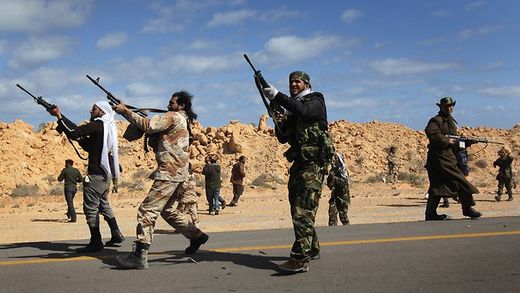
Almost 70 members of the former Libyan dictator's convoy were abused and executed after Gaddafi's own capture and death in the city of Sirte last October, the human rights group alleges.
The report - Death of a Dictator: Bloody Vengeance in Sirte - details Gaddafi's final hours and includes evidence that appears to prove captured pro-Gaddafi fighters caught attempting to leave the city, including Gaddafi's son Mutassim, were murdered.
Comment: Oh, so now they're militia forces?! First they were "al Qeada" (when they attacked us), then "Libyan rebels" (when we needed them for something we wanted), now "militias" (when they don't behave as we expect them to). Language for propaganda purposes sure is useful!
Mutassim was allegedly killed after being taken to Misrata, which suffered a months-long siege by pro-government troops. He had been filmed alive in the city earlier in the day, but later footage showed him dead from a fresh wound to the throat not visible in the first video after his capture.
Also killed, investigators believe, were at least 66 other members of the convoy, executed at the nearby Mahari Hotel.
While both sides committed atrocities, including murder, during the Libyan war's last battle, which saw some of the heaviest street fighting, this would be the worst single incident attributed to the coalition of anti-government militias.
Peter Bouckaert, emergencies director at Human Rights Watch, said: "The evidence suggests that opposition militias summarily executed at least 66 captured members of Gaddafi's convoy in Sirte."
The claims by the group are deeply embarrassing for Nato members that backed the rebel campaign to oust Gaddafi with a no-fly zone. That action - supported by Russia - was authorised because of fears that government forces might massacre civilians.
However, the apparent confirmation that anti-government militia forces were also responsible for war crimes that have yet to be investigated will once again raise serious questions over the nature of some of the groups backed by the west and its allies, some of whom have continued to fuel instability in the country.
"In case after case we investigated, the individuals had been videotaped alive by the opposition fighters who held them, and then found dead hours later," Bouckaert said. "Our strongest evidence for these executions comes from the footage filmed by the opposition forces, and the physical evidence at the Mahari Hotel, where the 66 bodies were found."
"It also looks as if they took Mutassim Gaddafi, who had been wounded, to Misrata and killed him there. Our findings call into question the assertion by Libyan authorities that Muammar Gaddafi was killed in crossfire, and not after his capture."
Among the most powerful new evidence is a mobile phone video clip filmed by opposition militia members that shows a large group of captured convoy members in detention, being cursed at and abused.
Human Rights Watch used hospital morgue photos to establish that at least 17 of the detainees visible in the phone video were later executed at the Mahari Hotel.
Under the laws of war, the killing of captured combatants is a war crime, and Libyan civilian and military authorities have an obligation to investigate war crimes and other violations of international humanitarian law.
A Human Rights Watch research team was nearby when Gaddafi's convoy engaged in its final battle with opposition forces, on 20 October 2011.
Following the battle, the research team visited the site and found more than 100 bodies, most killed in combat.
Two days later, the Human Rights Watch research team found the decomposing remains of at least 53 people at the nearby Mahari Hotel, some with their hands still bound behind their backs.
To document fully what had occurred on 20 October, the team interviewed officers in opposition militias who were at the scene, as well as surviving members of the Gaddafi convoy at the hospital, in custody, and in private homes.
The group also reviewed a large number of video recordings made by opposition forces on their mobile phones, some of which show captured detainees at the site of the final battle. Using Sirte hospital morgue records, Human Rights Watch researchers were able to establish the identities of 17 people last seen alive in custody whose bodies were recovered at the Mahari Hotel.
Among those executed was Ahmed Ali Yusuf al-Ghariyani, 29, a navy recruit originally from Tawergha. In a phone video that is believed to show him in captivity after the battle, militia forces beat, kick and throw shoes at him, and taunt him about being from Tawergha, a town seen as being loyal to Gaddafi. Ghariyani's body was later found at the Mahari Hotel, and was photographed by hospital staff and buried as unidentified body number 86. He was later identified by family members from the photographs taken by the hospital staff.
Journalists who covered the battle for Sirte also saw detainees being abused after their capture.



This is how the operate. It's how they operated when they massacred the Czar's family in Russia. It's what they do.
Israel is happy and that's all that matters.